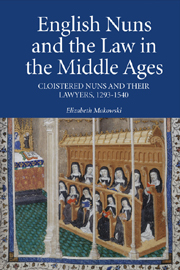Introduction
Published online by Cambridge University Press: 05 April 2013
Summary
In 1293, the first two communities of Franciscan nuns, referred to as Sorores Minores or Minoresses, were established in England. One was the Abbey of Waterbeach in Cambridgeshire, the other the London Minories. The rule in both monasteries required strict enclosure, and, unlike those English nuns upon whom cloister regulations were externally imposed, the Minoresses appear to have observed it. In subsequent years, three other mendicant houses, two more Franciscan and one Dominican, as well as the Bridgettine community of Syon, also observing strict enclosure, were founded. With the exception of Waterbeach, which was subsumed into the newly established house of Denney in the late fourteenth century, all of the monasteries survived as vital and economically sound institutions up to the time of the Dissolution, and in the case of Syon, beyond.
Confined to monastic precincts, these nuns depended first and foremost on landed endowments for their livelihood, and, like all substantial property owners in late medieval England, they were forced to engage in nearly constant litigation to defend them. Commenting on the astounding rate with which English men and women went to law in the fifteenth century, E. W. Ives estimated that the central common law courts alone heard 3,000 new suits a year.
- Type
- Chapter
- Information
- English Nuns and the Law in the Middle AgesCloistered Nuns and their Lawyers, 1293–1540, pp. 1 - 8Publisher: Boydell & BrewerPrint publication year: 2012



